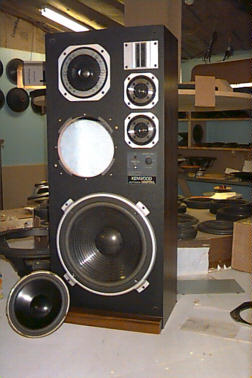|
A U
D I O... P A P E R SPEAKER TIPS for NON-AUDIOPHILES by Steve Deckert He brought in a pair of speakers, one pictured at the left, in hopes that I could repair them for him. I could see he thought they were really good speakers... and I didn't have the heart to tell him otherwise. I hope he doesn't bump into this page, or if he does, I hope he appreciates the education. After he left it dawned on me that so many people are like him, victims of ignorance, and by no fault of their own... really. So I thought I would just snap a picture of his speaker and use it as a visual aid to help educate the average person of the mass stereo crazed public! OKAY BEWARE - HERE WE GO! The speaker above looks pretty impressive doesn't it! Gee, with six drivers, the largest one being a 12", it's almost amazing it doesn't cost that much. If you were standing at your favorite stereo superstore looking at this speaker you might think the same thing. Your eyes caress the thick aluminum high tech looking components... and basic logic dictates that with six speakers it has to be better than some of the other cabinets in the room that have less! Then you notice situated just below the triple tweeter array a label that says DIGITAL READY. Well you're sure that must be good because everything today is going digital right? And some of the other speakers don't say that. Your mind begins to race and you pace around the room pretending to look at other speakers while the fantasy of showing these to your friends finishes playing out in your head. The salesman finally shows up and you ask him to play them for you. He turns them on and a'la your preconceived expectations, it sounds great, and loud too. Okay, okay, enough of that... Let's just get into the individual components and see what's really taking place here:
You see, if this speaker actually had what it appeared to have, that is to say high tech machined aluminum drivers, the components alone would run almost $700.00 for each speaker. Add the cabinets/grills/crossovers etc. and you'd be at around $1,100.00 ea. The irony is that if you found and old Yamaha, or JBL speaker with the real components this speaker tried to look like, they would never have this many drivers, because, generally, it doesn't sound good. Warning signs are easy to remember: Tap on the cabinet, sound hollow... walk away. Lift the cabinet, could you do it with ease?... walk away. Inspect the speakers... see any plastic?.... walk away. And finally realize that there is no such thing as really great speakers that somehow cost a fraction of what they should. Use common sense. In the hierarchy of quality, 1 being the lowest and 10 being the highest, today's example rates a 2.5 All I have to say to Kenwood and everyone else who does this is, "Shame on you!" There should be a warning label like cigarettes have that say "Imitation High Quality Speakers."
Decware is a trademark of High Fidelity Engineering
Co. |
